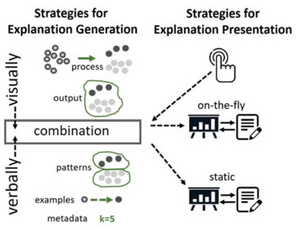Die Arbeitsgruppe zieht um!
Wir wechseln im Wintersemester 2021/22 an die Universität Bamberg. Ab 15. Oktober 2021 übernimmt Fabian Beck den dortigen Lehrstuhl für Informationsvisualisierung.
Neue Webseite der Arbeitsgruppe: https://www.uni-bamberg.de/vis
Publikationen
Publikationen der Arbeitsgruppe, die seit 2016 erschienen sind. Frühere Publikationen von Fabian Beck sind auf Google Scholar oder DBLP zu finden.

Art der Publikation: Beitrag in Sammelwerk
Going beyond Visualization: Verbalization as Complementary Medium to Explain Machine Learning Models
- Autor(en):
- Sevastjanova, Rita; Beck, Fabian; Ell, Basil; Turkay, Cagatay; Henkin, Rafael; Butt, Miriam; Keim, Daniel; El-Assady, Mennatallah
- Titel des Sammelbands:
- Workshop on Visualization for AI Explainability at IEEE VIS
- Veröffentlichung:
- 2018
- Volltext:
- Going beyond Visualization: Verbalization as Complementary Medium to Explain Machine Learning Models (351 KB)
- Zitation:
- Download BibTeX
Kurzfassung
In this position paper, we argue that a combination of visualization and verbalization techniques is beneficial for creating broad and versatile insights into the structure and decision-making processes of machine learning models. Explainability of machine learning models is emerging as an important area of research. Hence, insights into the inner workings of a trained model allow users and analysts, alike, to understand the models, develop justifications, and gain trust in the systems they inform. Explanations can be generated through different types of media, such as visualization and verbalization. Both are powerful tools that enable model interpretability. However, while their combination is arguably more powerful than each medium separately, they are currently applied and researched independently. To support our position that the combination of the two techniques is beneficial to explain machine learning models, we describe the design space of such a combination and discuss arising research questions, gaps, and opportunities.
